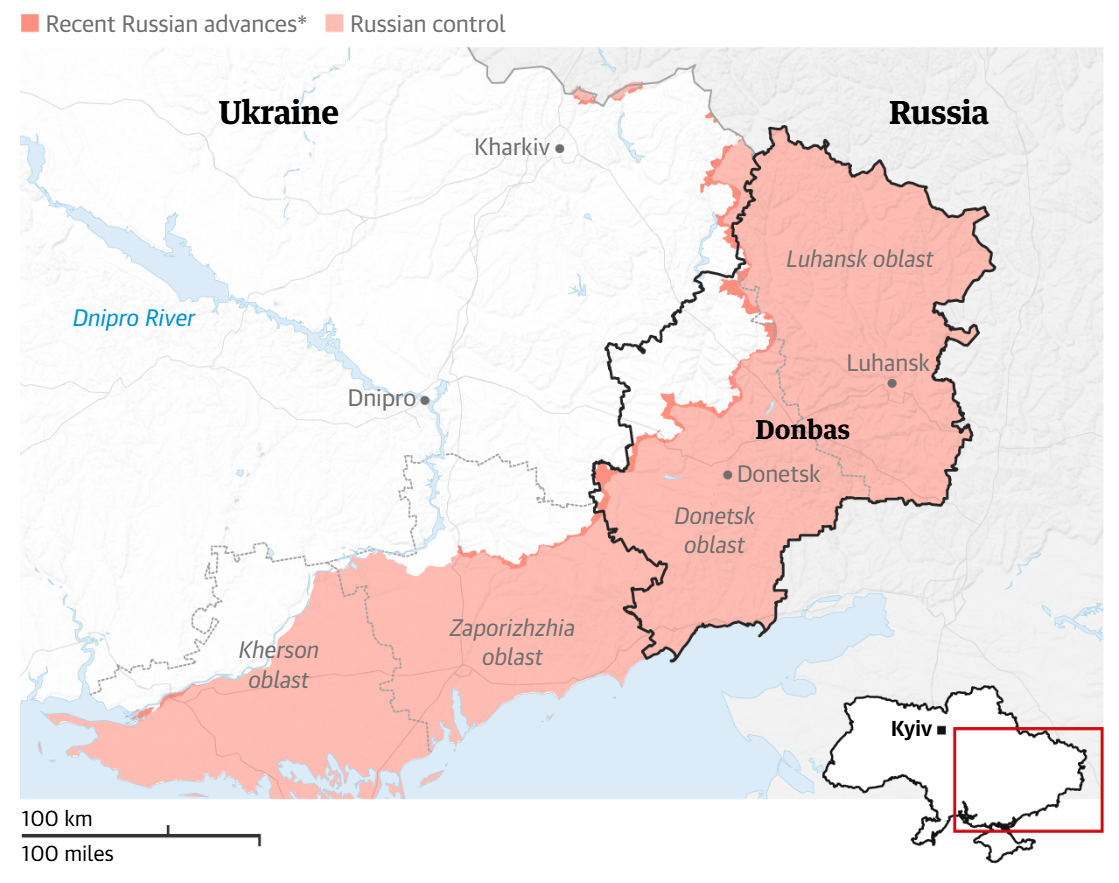Map of Proposed Donbas Cessions by Putin


David Chen
Data Visualization Specialist
David Chen is an expert in transforming complex geographic datasets into compelling visual narratives. He combines his background in computer science ...
Geographic Analysis
What This Map Shows
The map titled "Map of Proposed Donbas Cessions by Putin" visually represents the regions in eastern Ukraine that Russian President Vladimir Putin proposed Ukraine cede to Russia in exchange for ceasing hostilities during the ongoing conflict. The Donbas region, comprising Donetsk and Luhansk oblasts, has been a focal point of tension since 2014. This map delineates the territories that have been under contention, illustrating the geographic and strategic importance of these areas in the broader context of the conflict.
Deep Dive into the Donbas Region
The Donbas region is rich in both cultural and economic significance. Historically, it has been an industrial powerhouse, with coal mining and metallurgy forming the backbone of its economy. The area is characterized by a diverse population, consisting not only of ethnic Ukrainians but also a significant Russian-speaking community, which has been a source of division and tension.
Interestingly, the name "Donbas" is derived from the "Donets Basin," referring to the river system that runs through this area. The basin has played a crucial role in shaping the region's economy and demographics. With a population of approximately 6 million people, the Donbas has faced dramatic shifts due to the ongoing conflict, with significant displacement and migration patterns emerging since the war began.
The demographics of the Donbas are particularly noteworthy. According to recent statistics, the population has decreased due to the conflict, with many residents fleeing to safer regions or even abroad. The cities of Donetsk and Luhansk, once bustling urban centers, have suffered severe infrastructure damage and population decline. In addition, the region's economic output has plummeted, impacting not just local livelihoods but also the broader Ukrainian economy.
What's fascinating is how the geography of the Donbas influences military strategy. The region's flat terrain, interspersed with coal mines and industrial zones, provides both advantages and challenges for military operations. Control over these areas has significant implications for resource access, transportation routes, and overall power dynamics in the conflict.
Regional Analysis
When examining the map, it becomes evident that different areas within the Donbas exhibit unique characteristics. For example, the city of Donetsk, which has been partially controlled by Russian-backed separatists since 2014, showcases a stark contrast to the more stable regions of western Ukraine. As the capital of the Donetsk oblast, it was once a thriving economic hub, but now it lies in ruins, with reports indicating that many parts of the city are uninhabitable.
Conversely, Luhansk, another key city in the Donbas, has also faced immense challenges. The ongoing fighting has disrupted essential services and led to significant humanitarian crises. The map highlights these urban centers, as well as the surrounding rural areas, where the impact of the conflict has been felt differently. Rural communities often face additional challenges, including limited access to resources and healthcare, as they are further removed from the direct attention of governmental support systems.
Interestingly, the proposed cessions reflect not only territorial ambitions but also the strategic importance of controlling key industrial zones. For example, the areas rich in coal deposits are crucial for energy production, making them valuable assets in the ongoing conflict. The map serves as a reminder of how deeply interconnected geography, economics, and politics are in this region.
Significance and Impact
Understanding the implications of the proposed cessions in the Donbas is essential for grasping the larger geopolitical landscape. The conflict in Ukraine has far-reaching consequences, not just for the region but for international relations as well. The territorial disputes highlight questions of sovereignty, national identity, and the balance of power in Eastern Europe.
Moreover, the ongoing instability in the Donbas has led to a humanitarian crisis, with millions of people affected by displacement and violence. As of late 2023, reports indicate that over 1.5 million people have been internally displaced within Ukraine, many from the Donbas region. This raises pressing questions about the future of these communities and the potential for rebuilding in a post-conflict scenario.
Looking ahead, the situation in the Donbas remains fluid. The proposed cessions by Putin could signal a shift in strategy, but they also risk entrenching divisions and prolonging conflict. As negotiations continue, the map serves as a crucial tool for understanding the stakes involved, both for Ukraine and for the international community.
In conclusion, the "Map of Proposed Donbas Cessions by Putin" is not just a geographical representation; it encapsulates the complexities of a region where history, culture, and current events collide in dramatic ways. As the world watches, the fate of the Donbas will undoubtedly shape the future trajectory of Ukraine and its relationships with neighboring countries and global powers alike.
Visualization Details
- Published
- August 18, 2025
- Views
- 118
Comments
Loading comments...